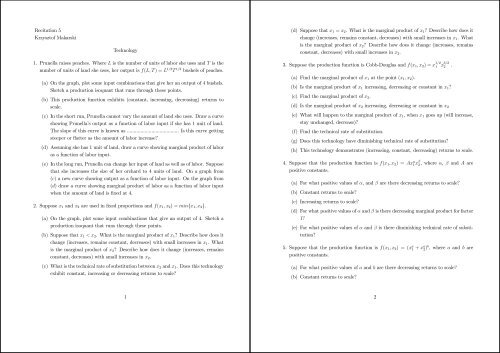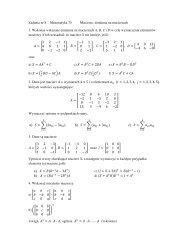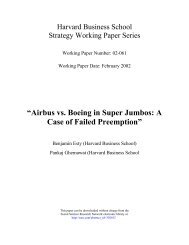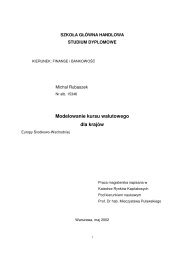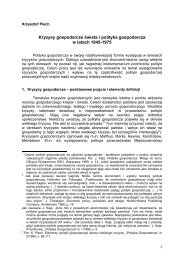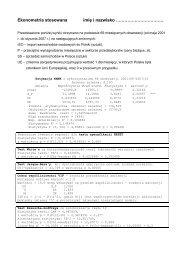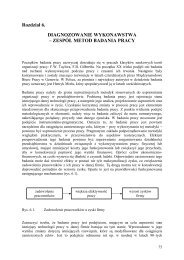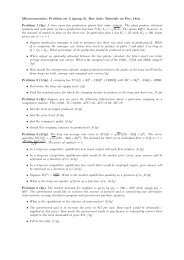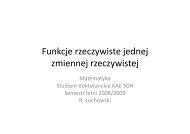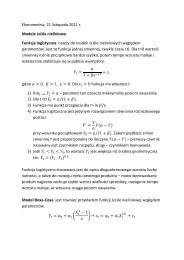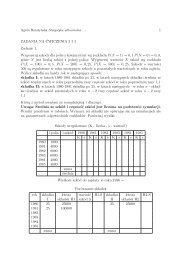Recitation 5 Krzysztof Makarski Technology 1. Prunella raises ...
Recitation 5 Krzysztof Makarski Technology 1. Prunella raises ...
Recitation 5 Krzysztof Makarski Technology 1. Prunella raises ...
Create successful ePaper yourself
Turn your PDF publications into a flip-book with our unique Google optimized e-Paper software.
<strong>Recitation</strong> 5<br />
<strong>Krzysztof</strong> <strong>Makarski</strong><br />
<strong>Technology</strong><br />
(d) Suppose that x 1 = x 2 . What is the marginal product of x 1 ? Describe how does it<br />
change (increases, remains constant, decreases) with small increases in x 1 .What<br />
is the marginal product of x 2 ? Describe how does it change (increases, remains<br />
constant, decreases) with small increases in x 2 .<br />
<strong>1.</strong> <strong>Prunella</strong> <strong>raises</strong> peaches. Where L is the number of units of labor she uses and T is the<br />
number of units of land she uses, her output is f(L, T )=L 1/2 T 1/2 bushels of peaches.<br />
(a) On the graph, plot some input combinations that give her an output of 4 bushels.<br />
Sketch a production isoquant that runs through these points.<br />
(b) This production function exhibits (constant, increasing, decreasing) returns to<br />
scale.<br />
(c) In the short run, <strong>Prunella</strong> cannot vary the amount of land she uses. Draw a curve<br />
showing <strong>Prunella</strong>’s output as a function of labor input if she has 1 unit of land.<br />
The slope of this curve is known as ...................................... Is this curve getting<br />
steeper or flatter as the amount of labor increase?<br />
(d) Assuming she has 1 unit of land, draw a curve showing marginal product of labor<br />
as a function of labor input.<br />
(e) In the long run, <strong>Prunella</strong> can change her input of land as well as of labor. Suppose<br />
that she increases the size of her orchard to 4 units of land. On a graph from<br />
(c) a new curve showing output as a function of labor input. On the graph from<br />
(d) draw a curve showing marginal product of labor as a function of labor input<br />
when the amount of land is fixed at 4.<br />
2. Suppose x 1 and x 2 are used in fixed proportions and f(x 1 ,x 2 )=min{x 1 ,x 2 }.<br />
(a) On the graph, plot some input combinations that give an output of 4. Sketch a<br />
production isoquant that runs through these points.<br />
(b) Suppose that x 1
(c) Increasing returns to scale?<br />
Cost Minimization<br />
Profit Maximization<br />
<strong>1.</strong> A Los Angeles firm uses a single input to produce a recreational commodity according<br />
to a production function f(x) =16 √ x,wherex is the number of units of input. The<br />
commodity sells for $100 per unit. The input costs $50 per unit.<br />
(a) Write down a function that states the firm’s profit as a function of the amount of<br />
input.<br />
(b) What is the profit-maximizing amount of input and of output? How much profits<br />
does it make when it maximizes profits? Show this case on a graph.(Hint: A good<br />
way to solve this is to write an expression for the firm’s profit as a function of its<br />
input and solve for the profit-maximizing amount of input.)<br />
(c) Suppose that the firm is taxed $50 per unit of its output. What is its new level<br />
of input and of output? How much profit doesitmakenow? Whatisthetotal<br />
tax collection?<br />
(d) Suppose that instead of these taxes, the firm is taxed at 50% of its profits. Write<br />
down its after-tax profits as a function of the amount of input. What is the profitmaximizing<br />
amount of output and of output? How much profit doesitmakeafter<br />
taxes? What is the total tax collection?<br />
2. A firm has two variable factors and a production function, f(x 1 ,x 2 )=x 1/2<br />
1 x 1/4<br />
2 . The<br />
price of its output is 4. Factor 1 receives a wage of w 1 and factor 2 receives a wage of<br />
w 2 .<br />
(a) Find the amounts of both factors that maximize the firm’s profits as a function<br />
of w 1 and w 2 .<br />
(b) Suppose w 1 =2,andw 2 =1, find x 1 and x 2 . How much output will be produced?<br />
How much profit will be made?<br />
3. A firm has two variable factors and a production function f(x 1 ,x 2 )=x 1/2<br />
1 x 1/2<br />
2 . The<br />
price of its output is 4, the price of factor 1 is w 1 , and the price of factor 2 is w 2 .Can<br />
you find uniquely x 1 and x 2 ?Why?<br />
<strong>1.</strong> A firm uses labor and machines to produce output according to the production function<br />
f(L, M) =4L 1/2 M 1/2 ,whereL is the number of units of labor used and M is the<br />
number of machines. The cost of labor is $40 per unit and the cost of using a machine<br />
is $10.<br />
(a) Draw an isocost line for this firm, showing combinations of machines and labor<br />
that cost $400 and another isocost line showing combinations that cost $200.<br />
What is the slope of these isocost lines?<br />
(b) Suppose that the firm wants to produce its output in the cheapest possible way.<br />
Find the number of machines it would use per worker. (Hint: The firm will<br />
produce at a point where the slope of the production isoquant equals the slope of<br />
the isocost line.)<br />
(c) On a graph from (a) sketch the production isoquant corresponding to an output<br />
of 40. Calculate the amount of labor units and the number of machines that are<br />
used to produce 40 units of output in the cheapest possible way, given the above<br />
factor prices. Calculate the cost of producing 40 units at these factor prices.<br />
(d) How many units of labor and how many machines would the firm use to produce<br />
y units in the cheapest possible way? How much would this cost? (Hint: Notice<br />
that there are constant returns to scale.)<br />
2. Earl sells lemonade in a competitive market on a busy street corner in Philadelphia.<br />
His production function is f(x 1 ,x 2 )=x 1/3<br />
1 x 1/3<br />
2 ,where output is measured in gallons, x 1<br />
is the number of pounds of lemons he uses, and x 2 is the number of labor-hours spent<br />
squeezing them.<br />
(a) Does Earl have constant returns to scale, decreasing returns to scale, or increasing<br />
returns to scale?<br />
(b) Suppose that he is going to produce y units in the cheapest way possible. What<br />
number of pounds of lemons will he use? What number of hours of labor that<br />
will he use? (Hint: Use the production function and the equation you found in<br />
the last part of the answer to solve for the input quantities.)<br />
(c) Find the expression for the cost to Earl of producing y units at factor prices w 1<br />
and w 2 .<br />
3<br />
4
3. Joe Grow, an avid indoor gardener, has found that the number of happy plants, h,<br />
depends on the amount of light, l, andwater,w. In fact, Joe noticed that plants<br />
require twice as much light as water, and any more or less is wasted. Thus, Joe’s<br />
production function is h = min{l,2w}.<br />
(a) Suppose Joe is using 1 unit of light, what is the least amount of water he can use<br />
and still produce a happy plant?<br />
(b) Suppose Joe wants to produce 4 happy plants, what are the minimum amounts<br />
of light and water required?<br />
(c) Find Joe’s conditional factor demand function for light and his conditional factor<br />
demand function for water.<br />
(d) If each unit of light costs w 1 and each unit of water costs w 2 , find Joe’s cost<br />
function.<br />
4. Joe’s sister, Flo Grow, is a university administrator. She uses an alternative method<br />
of gardening. Flo has found that happy plants only need fertilizer and talk. (Warning:<br />
Frivolous observations about university administrators’ talk being a perfect substitute<br />
for fertilizer is in extremely poor taste.) Where f is the number of bags of fertilizer<br />
used and t isthenumberofhoursshetalkstoherplants,thenumberofhappyplants<br />
produced is exactly h = t +2f. Suppose fertilizer costs w f per bag and talk costs w t<br />
per hour.<br />
(b) How many units of input does it take to produce 10 units of output? If the input<br />
costs w per unit, what does it cost to produce 10 units of output?<br />
(c) How many units of input does it take to produce y units of output? If the input<br />
costs w per unit, what does it cost to produce y units of output?<br />
(d) If the input costs w per unit, what is the average cost of producing y units?<br />
6. A university cafeteria produces square meals, using only one input and a rather remarkable<br />
production process. We are not allowed to say what that ingredient is, but an<br />
authoritative kitchen source says that “fungus is involved.” The cafeteria’s production<br />
function is f(x) =x 2 ,wherex is the amount of input and f(x) is the number of square<br />
meals produced.<br />
(a) Does the cafeteria have increasing, constant, or decreasing returns to scale?<br />
(b) How many units of input does it take to produce 144 square meals? If the input<br />
costs w per unit, what does it cost to produce 144 square meals?<br />
(c) How many units of input does it take to produce y square meals? If the input<br />
costs w per unit, what does it cost to produce y square meals?<br />
(d) If the input costs w per unit, what is the average cost of producing y square<br />
meals?<br />
(a) If Flo uses no fertilizer, how many hours of talk must she devote if she wants one<br />
happy plant? If she doesn’t talk to her plants at all, how many bags of fertilizer<br />
will she need for one happy plant?<br />
(b) If w t


